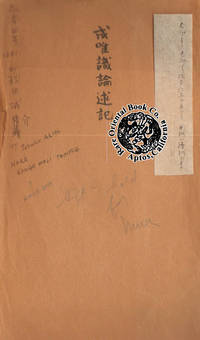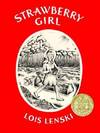[Nara 1258, Kongo Hoji-Ji]. Folded Buddhist sutra, 16.2 x 29 cm. wide, 28 folded leaves, 8 columns of Kanji per page, 21 Kanji characters per column, woodblock printed, red brush dots as grammatical marks, printed on stiff, strong Washi. The title for this in Chinese is CHENG WEI SHI LUEN SHU JI. A Chinese Buddhist Treatise/Sutra, most likely brought from China to Japan by Kukai. * Chinese internet sources stated about this work: 'As main object is discussed, the "Cheng wei shi lun Shuji," is very detailed, "'o world all things all Lai Ye knowledge is changed, there is "no" circumstances "only" inside "knowledge." At the same time with the help of Hetuvidya, Buddhism, and Theravada Buddhism outside critique of various schools of philosophy.' The Chinese title translates into something like: "As discussed in note Consciousness," meaning: "INTRODUCTION FOR DISCOURSE ON THE THEORY OF CONSCIOUSNESS." * The earliest Japanese Buddhist written documents, treatises and Sutras were brought to Japan by the celebrated and most famous Japanese Buddhist monk, Kukai [774-835], posthumously and popularly known as Kobo Daishi. . WHO WAS KUKAI: The original title was most likely copied by Kukai. He belonged to a long line of famous Buddhist scholars. He was the first disciple of Gonso, then attended Daigakuryo [ancient university] to study Confucianism and Buddhism. . Kukai became a priest at Makioji Temple, Osaka in 792. Not satisfied with the standards of Buddhist teachings in those days, he decided to go to China for further study and spend several years in preparation. Finally he accompanied the Japanese envoy to China and studied Buddhism at various temples there and also collected and copied a large number of religious books, which he brought back to Japan in 804 A.D. . Upon his return in 806 A.D., Kukai was received by Emperor Heizei and obtained the Imperial sanction to promulgate esoteric Buddhism in Japan. He was appointed head priest of Todaiji Temple in Yamato province, now Nara, in 810 A.D. Kukai was given Mt. Koya, where he built Kongobuji Temple in 816 and then set forth on a preaching mission in north-east Japan. Kukai was the inventor of Hiragana, the writer of the Iroha poem and above all created Shinto religion, unique to Japan. Kukai retired at Mt. Koya, where he died in 835 A.D. . Kukai was the founder of the Shingon Sect of Buddhism. We believe this example was one of a good number of Buddhist texts & treatises Kukai brought back to Japan from China in 804 A.D. . The above liberally extracted from Japan Biographical Encyclopedia, see below for more details. ***** THIS BUDDHIST TREATISE/SUTRA: This is a mid-Kamakura period [1185-1336] Buddhist Treatise/Sutra, dated Koan 4th year [1281] on the brown folder enclosing the work. From the style of the characters and superb quality of the stiff paper, the work is consistent with that date. . Buddhist Treatises/Sutras were always the property of Buddhist temples. Occasionally patrons who donated large sums of money to assist temples in need of repair & restoration were given as "honorarium" and in recognition of their "Good Deed." They were commonly given a gift of an early Buddhist Treatise/Sutra in gratitude by the head Abbott/monk or priest. This item is a fine example of this ancient custom. . The Treatise/Sutra is in two disconnected but related parts. The first part consists of 24 2/3rds pages; the second consists of 3 1/4 pages. . The two parts do not connect, but are clearly from the same Treatise/Sutra. There is no beginning nor end page, these are essentially two "fragments" from the original period work. *** . STATEMENTS ON THE BROWN FOLDER HOLDING THE TREATISE/SUTRA: . The two Treatise/Sutra parts were contained in a brown folder with the following hand-written title and text: The Sutra came from the "NARA KONGO HOJI TEMPLE" located in old Yamato province now called Nara, located at the top of Mt. Keya. . The brown folder states: "Koan 4th year" which is 1281 A.D. With the commend: "By Akita Josuke," but after an exhaustive search we can not find any information about this person. . The title is written in black-Sumi ink Fude [Japanese bamboo brush] strokes for 6 Kanji characters reading: "SE I YU I SHIKI RON JUTSU KI" or meaning in English: "INTRODUCTION FOR DISCOURSE ON THE THEORY OF CONSCIOUSNESS." . In addition, there is a small white slip of paper attached to the brown folder, with Japanese that we translated into English, meaning: "This Treatise/Sutra was not made as a 'scroll type' format, it was originally made as a 'folding type scroll-book' [accordion-folded woodblock printed book format], printed on 'composite' paper.'" *** THE TWO PARTS OF THE SUTRA: The first part consists of 24 2/3rds pages; the second part consists of 3 1/4 pages. Each page is 16.3 x 18.9 cm. The leaves are accordion folded, they are of identical size. . The two parts are not connected but are from the same work or Sutra. There is no beginning nor end, these are essentially two 'fragments' or pieces from the original period work. . Each page contains 8 lines of text, 21 Chinese character per vertical line, called Kambun [Chinese writing] by the Japanese, meaning 'Chinese text.' There are red ink "grammatical" brush marks and other Furigana in red to make the text readable by Japanese. *** PHOTOGRAPHIC IMAGES OF THE SUTRA: We have posted several photos of the parts of the treatise/Sutra to our website. Please see the color photos posted to our website, Starting with: cover.jpg, illus02.jpg through illus11.jpg are the larger part; while illus12.jpg & illus13.jpg are the second and smaller part. **** CONDITION: The work is woodblock printed with beautiful and very vivid black, bold Chinese [Kambun] characters, printed on very strong and substantial Washi [hand-made] hand-made Japanese paper. . There are a good number of old worm holes, all of which have been properly restored in the ancient past on the verso [back side] using old, period Washi paper. There are also a few old mends to the verso hinged folds. . These restorations do not seriously detract from the whole, being some 733 years old, one expects their to be some attrition. The work is now solid and folds nicely, there are no other issues. . An excellent and RARE example of mid-Kamakura [13th century] era woodblock printing and Washi paper. *** TITLE: The title is recorded on the brown paper folder. There is no title page on the work, therefore we call it a 'fragment.' . Knowing little about this work, we were inspired to bring it to a large Buddhist temple in China, to inquire about it. In March, 2014, we visited the largest Buddhist temple in Nanning city, Guangxi province, southern China. . AUTHENTICATION/CONFIRMATION: The work was brought to Nanning, Guangxi Province Buddhist temple, named QIN SHANG GUAN YIN SHI [GREEN MOUNTAIN TEMPLE OF THE GODDESS OF MERCY],located at Mt. Qingxiu. . The old Buddhist Abbott looked at this work. I asked him if he recognized the work, but he did not. I asked about the contents, the Abbott replied, the work was a "Fójiào Lùnwén" [Buddhist Treatise, i.e. a "paper"] or "Lun Wen" for short. He confirmed the period was correct based on the style of the Hanzi [Chinese characters], type of and the very high-quality of the ancient paper, the format of the printing columns and content of the text. . After reading through the text, the old Abbott stated there was a lot about the correct kinds of food to eat, vegetarian dishes, Doufu [Tofu], prohibitions about not eating meat or animal products. While he was reluctant to give me anything in writing, His impressions and comments were valuable. The old Abbott did not ask for a fee but appeared to be quite delighted to see such an ancient and beautifully preserved example of a Buddhist treatise. He did comment on the lovely old traditional style Hanzi [Chinese] characters. *** PROVENANCE: This item came from the personal and private collection of Muir Dawson, late owner of Dawson's Bookshop, ABAA, Los Angeles, California. It was part of a group of items that were held back by Muir in his private collection. The brown sleeve has some recent scotch tape reinforcement on the inside folds. . The brown paper sleeve has a pencil note in Muir's hand: "Gift-hold for Muir." . Muir Dawson was an old friend. We knew of his private collection of superb examples of old printing, among which he had several stunning ancient Japanese examples. He was a fan of printing in all its forms and cultures. He and his store had close a relationship with Japan during the 1950-1970's and he pulled aside several fine items that came into his shop for his own personal collection. This item was one of those examples. *** REFERENCES: . BUDDHIST PRINTING: . a. * BUDDHIST PRINTING: . NARA NATIONAL MUSEUM.ARTS OF THE LOTUS SUTRA: please see the Kamakura or 13th century listings, from ca. pp.72-135. . BASKETT, Mary W.: FOOTPRINTS OF THE BUDDHA: Japanese Buddhist Prints from American and Japanese Collections. [Exhibition] August 23 to October 26, 1980 * ROSENFIELD, John: JAPANESE ARTS OF THE HEIAN PERIOD 794-1185. * SATOW, Ernest M.:ON THE EARLY HISTORY OF PRINTING IN JAPAN. see p.53 et al. * NARA NATIONAL MUSEUM: ARTS OF THE LOTUS SUTRA. * *** EARLY WASHI PAPERMAKING: . b. * EARLY WASHI PAPERMAKING: NARITA, Kiyofusa: JAPANESE PAPERMAKING. . NARITA, Kiyofusa: A LIFE OF TS'AI LUNG AND JAPANESE PAPER-MAKING. * HORIKOSHI, Jusuke: KAMI KOSHII CHOHO-KI: DIARY OF JAPANESE PAPERMAKING. * TINDALE, Thomas K. et al.: THE HANDMADE PAPERS OF JAPAN. . *** HISTORIC RESOURCES: . c. * HISTORIC RESOURCES: SANSOM, George B. A HISTORY OF JAPAN: To 1334, pp.424-437. * PAPINOT, E. HISTORICAL AND GEOGRAPHICAL DICTIONARY OF JAPAN: see pp.815,882, et al., map of Kinai. * JAPAN BIOGRAPHICAL ENCYCLOPEDIA AND WHO'S WHO.1964-'65 edition, pp. 292, 321, 721-722. * KUKAI: Kobo Daishi: http://en.wikipedia.org/wiki/K%C5%ABkai * BRINKLEY, F.: A HISTORY OF THE JAPANESE PEOPLE: From the Earliest Times to the End of the Meiji Era: pp.760 index for Kukai and many entries, et al. *** .

(US)





